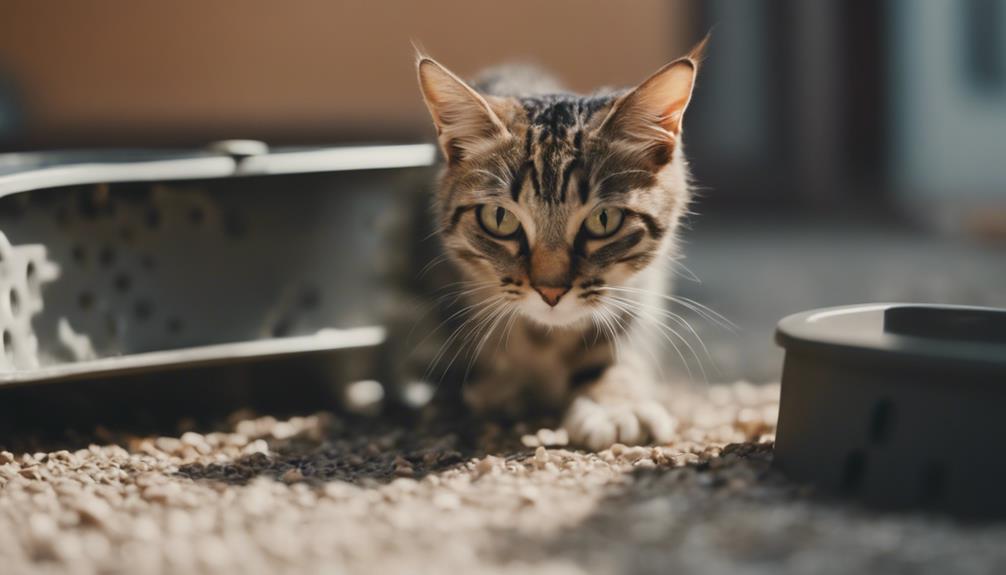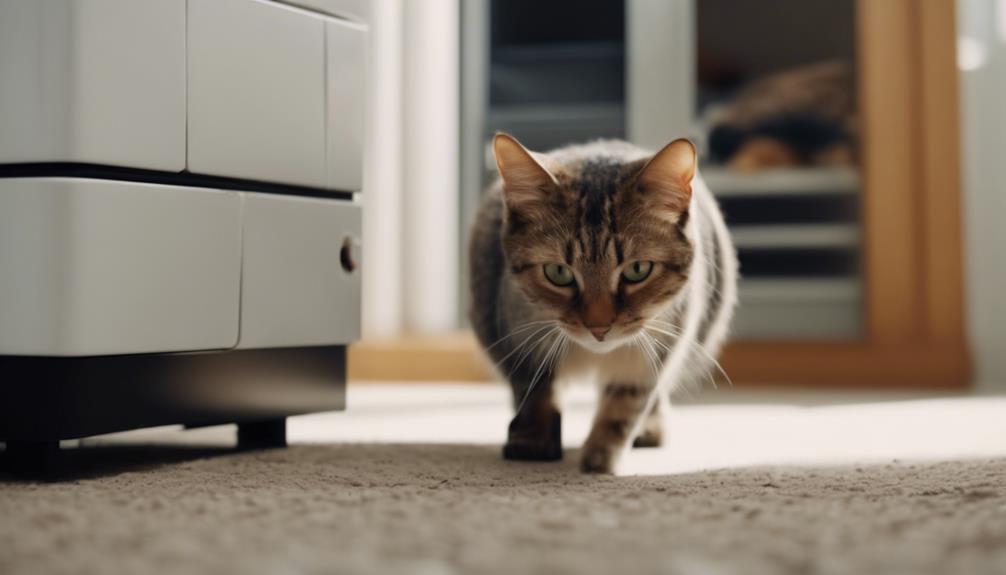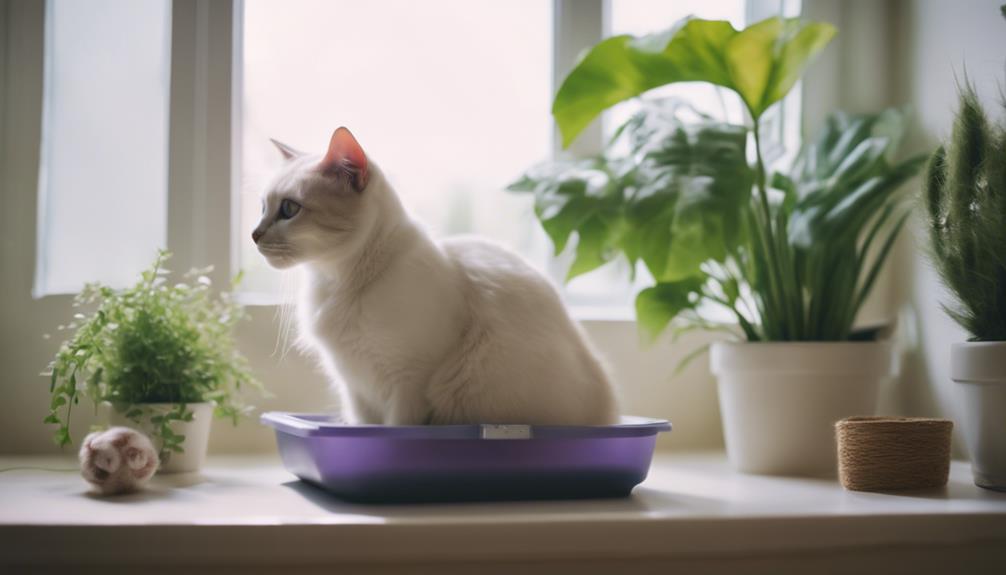In the realm of feline behavior lies a mystery that has puzzled cat owners for generations – how do cats instinctively know to use the litter box?
As we observe our feline companions effortlessly adapting to this designated spot for their waste, one cannot help but wonder about the underlying mechanisms guiding this behavior.
While some may attribute it solely to innate instincts, there might be more to this seemingly mundane act than meets the eye.
Stay tuned as we unravel the intricacies of feline cognition and delve into the enigmatic world of litter box etiquette.
Key Takeaways
- Cats instinctively cover waste to avoid predators, aiding in their natural inclination to use the litter box.
- Cats can adapt to litter boxes without direct training, transitioning easily with proper guidance.
- Changes in behavior may signal litter box issues; consult a vet for persistent problems.
- Cats locate the litter box easily with a keen sense of smell; provide multiple boxes for accessibility.
Instincts Drive Cats to Litter Box
Instincts play a pivotal role in guiding cats to use the litter box effortlessly. Cats have a natural inclination to bury their waste as a survival instinct to avoid predators in the wild. This behavior stems from their ancestors, who would cover their scent to remain undetected.
Newborn kittens also rely on instinct, needing stimulation from their mother to eliminate. Even stray cats can transition to using litter boxes with minimal guidance, showcasing the innate nature of this behavior.
Cats' predisposition to dig and cover their waste makes adapting to the litter box a seamless process for most felines. Understanding these instinctual behaviors can aid in creating a suitable environment for successful litter box usage.
Training Kittens for Litter Box
Training kittens for proper litter box usage is a crucial aspect of fostering good bathroom habits in young felines. When it comes to training kittens for the litter box, it's essential to remember a few key points:
- Start early: Introduce kittens to the litter box as soon as they are weaned.
- Use the right litter: Choose a litter that is soft and unscented to attract kittens to the box.
- Positive reinforcement: Reward kittens with treats or praise when they use the litter box correctly.
Transitioning Stray Cats to Litter Box

To effectively help stray cats adapt to using a litter box, it is essential to create a comfortable and inviting environment that encourages proper bathroom habits. When transitioning stray cats to a litter box, start by providing a quiet and secluded area with easy access to the litter box.
Use unscented, clumping litter similar to what the cat may have encountered outdoors. Place the cat in the litter box after meals or naps to establish a routine. If the cat eliminates outside the box, place the waste in the litter box to familiarize them with its purpose.
Patience and positive reinforcement are key to helping stray cats successfully adjust to using a litter box.
Behavioral Issues With Litter Box
Cats may develop behavioral issues related to using the litter box due to various factors that can affect their bathroom habits. These issues can be challenging for both the cat and the owner to manage, but understanding the underlying causes is crucial for finding solutions.
Here are some common factors contributing to behavioral problems with the litter box:
- Environmental stressors like changes in the household routine
- Medical conditions such as urinary tract infections
- Previous negative experiences with the litter box
Addressing these issues promptly and working closely with a veterinarian can help resolve behavioral problems and ensure your cat's litter box habits remain healthy and consistent.
Finding Moved Litter Box

When relocating a litter box, ensuring that it remains within the cat's familiar environment can facilitate the feline's ability to locate it efficiently. Cats rely heavily on their sense of smell to find their litter box, so maintaining consistency in its location is crucial.
Providing multiple litter boxes in different areas of the home can also aid in accessibility, especially in multi-level households. Encouraging cats to find the litter box on their own by initially guiding them to the new location can be beneficial.
Placing litter boxes in quiet areas where the cat feels safe and comfortable is preferred. It's important to remember that cats may need some time to adjust to the new location, so patience and consistency are key in helping them adapt successfully.
Reasons for Going Outside Box
Relocating a litter box can sometimes result in cats exhibiting behaviors such as going outside the box, which may stem from various underlying reasons. Cats can be quite particular about their bathroom habits, and any changes to their usual setup can lead to unexpected behavior.
Some common reasons for cats going outside the litter box include:
- Stress or anxiety from changes in the environment
- Medical issues like urinary tract infections or kidney problems
- Dislike of the litter type or cleanliness of the box
Understanding these potential reasons can help cat owners address the issue effectively and ensure their feline friends have a comfortable and suitable bathroom environment.
Impact of Environmental Factors

Environmental factors play a significant role in influencing a cat's behavior towards the litter box. The type of litter used, cleanliness of the box, and the location of the box all play a part in whether a cat will use it consistently. Here is a table outlining some key environmental factors affecting a cat's litter box behavior:
| Environmental Factor | Impact on Cat's Behavior towards Litter Box |
|---|---|
| Type of Litter | Some cats prefer specific textures or scents. Choosing the right litter type can encourage regular use. |
| Box Cleanliness | Cats are clean animals and may avoid a dirty box. Regular scooping and changing of litter are essential. |
| Box Location | Quiet, accessible areas are preferred by cats. Placing the box in a calm space can promote consistent use. |
Monitoring Health for Litter Box
To ensure the overall well-being of your feline companion, it is imperative to prioritize regular veterinary examinations to monitor any potential health issues that could impact their litter box behavior. Regular vet check-ups play a crucial role in maintaining your cat's health and addressing any concerns promptly.
Here are three key points to consider:
- Regular vet examinations help detect early signs of medical conditions affecting litter box habits.
- Monitoring your cat's health can prevent serious illnesses that might manifest through changes in litter box behavior.
- Veterinary guidance can provide insights into maintaining your cat's litter box routine as a part of their overall health management.
Conclusion
In conclusion, the innate instincts of cats drive them to use the litter box, a behavior deeply rooted in their ancestral heritage.
While some may argue that cats are simply creatures of habit and can be difficult to train, understanding the complex interplay of instincts, training, and environmental factors is crucial in ensuring successful litter box usage.
By appreciating the intricate dynamics at play, cat owners can better address any challenges that may arise in this essential aspect of feline care.




